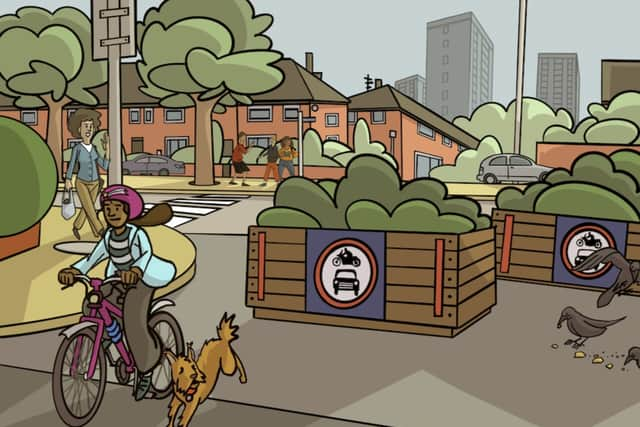Uni researchers call for total ban on pavement parking to boost walking and cycling in Manchester
and live on Freeview channel 276
Pavement parking should be banned and more School Streets introduced to encourage people to make local journeys by walking or cycling, researchers have said.
A team at the University of Salford has made the recommendations in a report looking at the introduction of active travel neighbourhoods across Greater Manchester.
Advertisement
Hide AdAdvertisement
Hide AdThe project involved engaging with residents in four neighbourhoods with active travel measures in place to understand the impact of bringing them in on people from different walks of life.
Now, in the wake of its research, it has suggested what the authorities should do next to get more people out and about on foot or on two wheels.


What recommendations have the researchers made?
The researchers said pavement parking should be completely banned as part of active neighbourhood projects.
This would bring the Greater Manchester schemes in line with a pavement prohibition which exists throughout London.
Advertisement
Hide AdAdvertisement
Hide AdThe team came to this conclusion after being told that vehicles being parked on pavements often creates a lack of space, making walking difficult for disabled residents or people with children or prams.
The researchers were also told residents felt like the active neighbourhood schemes did more to boost cycling than they did for getting about on foot.
The other major recommendation from the research is that more School Streets should be rolled out in active neighbourhoods to help parents who might want to cycle or walk to school with their children.
School Streets involve closing roads outside schools to motor traffic at morning drop-off and afternoon pick-up times and can help to improve road safety, reduce anti-social behaviour associated with parking and poor driving on the school run and ultimately reduce the amount of traffic taking pupils to and from their lessons each day.
How was the research done?
Advertisement
Hide AdAdvertisement
Hide AdThe researchers worked with the support of Transport for Greater Manchester (TfGM) and the Higher Education Innovation Fund (HEIF).
They worked with residents in four active travel neighbourhoods across Greater Manchester: Trinity and Islington in Salford, Levenshulme in Manchester, Garside Hey Road in Bury and Cheadle Heath in Stockport.
The four locations were chosen to reflect a variety of circumstances and life situations.
Active travel neighbourhoods, which are also sometimes known as low traffic neighbourhoods (LTNs), actively restrict motor vehicles from accessing certain streets and therefore remove through traffic.
Advertisement
Hide AdAdvertisement
Hide AdThe idea is that this will encourage people to walk or cycle more and make the streets pleasant places where residents would wish to spend more time.
However, LTNs have proven controversial and Manchester has been no exception, with residents’ groups both in favour of and in opposition to the Levenshulme scheme in existence.
TfGM is looking to improve the take-up of walking and cycling, especially for local journeys, and is currently running a programme to try to deliver as many as 50 School Streets across Greater Manchester’s 10 local authorities.
Did the researchers make any more recommendations?
The researchers said the authorities needed to speak to residents more about active travel neighbourhoods at the outset of introducing schemes to ensure that they are inclusive, accessible and enjoy broad community support.
Advertisement
Hide AdAdvertisement
Hide AdFurther engagement work needs to be done with community groups, older people and disabled people to ensure they can air any concerns they have and help to shape the final plans.
Other recommendations included setting up Active Neighbourhood forums and communicating monitoring and evaluation measures.
What has been said about the research and recommendations?
Richard Nickson, programme director for cycling and walking at TfGM, said: “Simply put, Active Neighbourhoods are places where people are prioritised over cars. They’re safe spaces where people can chat and kids can play out – and it’s also easier to get around on foot or by bike.
“They also link into Greater Manchester’s vision for a joined-up Bee Network, linking cycling and walking with buses, trains and Metrolink services.
Advertisement
Hide AdAdvertisement
Hide Ad“Measures like banning pavement parking and introducing more School Streets can have real advantages so it’s great that the study picked up on these points.
“But we do also know that people may have questions or concerns, and it’s great we have also had feedback about what we can do to ensure our engagement is even better.
“That is why studies of this nature are critical – along with listening to people’s feedback – so we know what we can do to improve.”
Harriet Larrington-Spencer, researcher for Healthy Active Cities in the School of Health and Society at the University of Salford, said: “Looking at better use of road space to encourage walking and cycling within cities is essential to tackle the climate crisis, as well as to help people to keep active.
Advertisement
Hide AdAdvertisement
Hide Ad“The question isn’t really whether we reallocate road space, but how we do it to make sure that we support people who might otherwise face barriers in accessing their local neighbourhoods such as disabled and older people, and, increasingly, children.”
